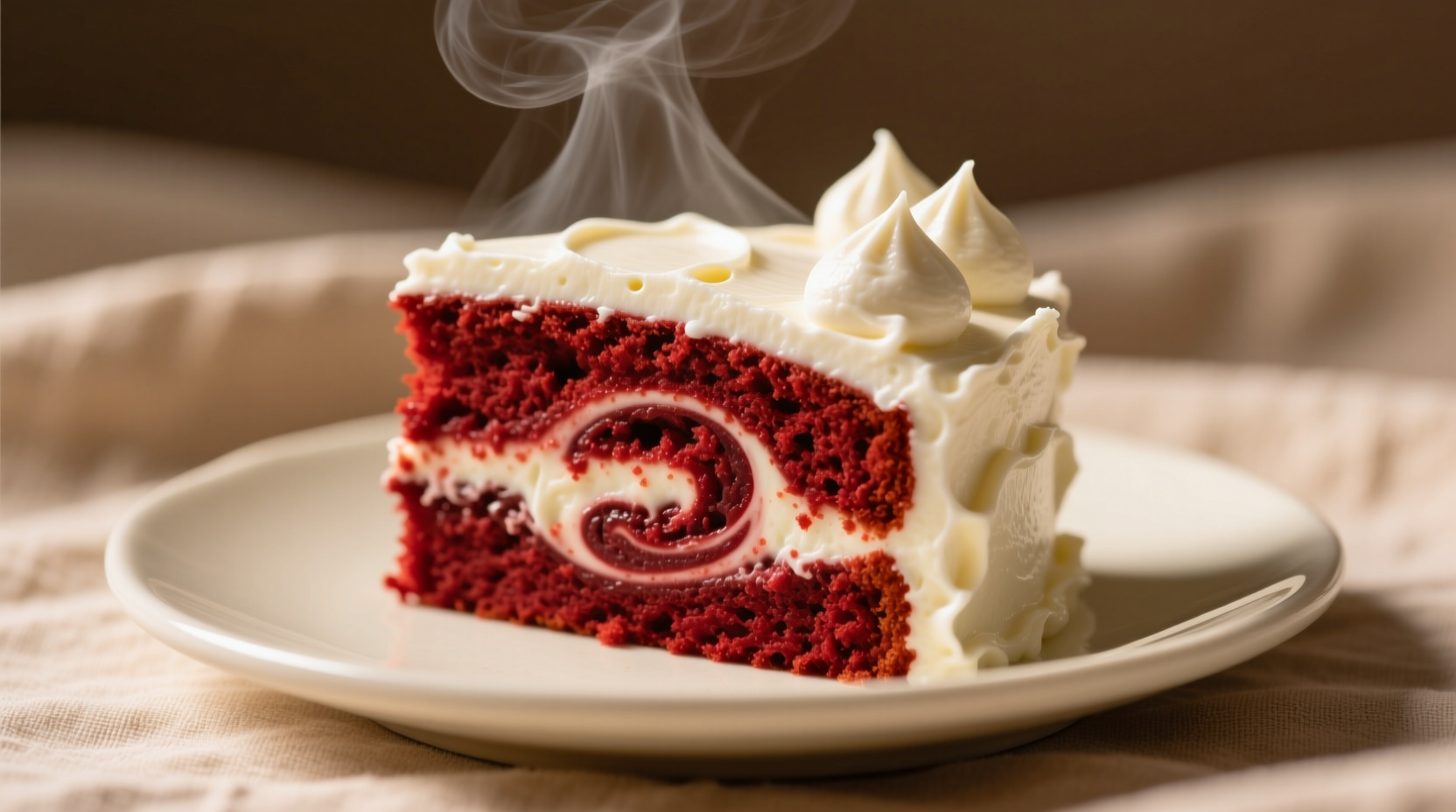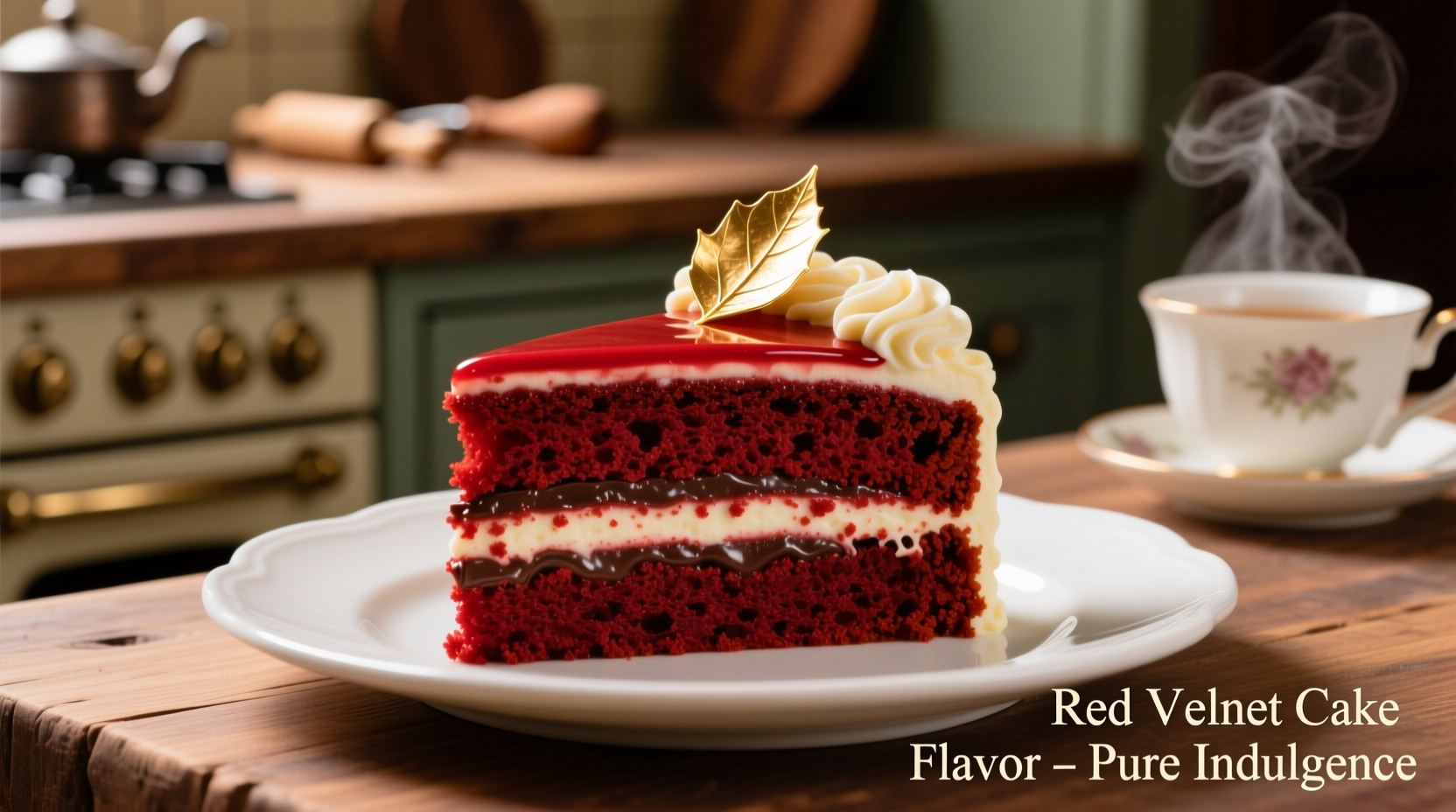Red velvet cake flavor is a distinctive blend of mild cocoa, tangy buttermilk and vinegar, subtle spices like cinnamon, and a hint of vanilla—not simply chocolate cake with red dye. The unique flavor profile balances sweetness with a slight acidity and earthy cocoa notes, creating a sophisticated taste that's lighter than traditional chocolate cake.
For decades, red velvet cake has captivated dessert lovers with its striking color and mysterious flavor profile. If you've ever wondered what gives red velvet cake its distinctive taste beyond just the red color, you're not alone. Many mistakenly believe it's merely chocolate cake with food coloring added, but the truth reveals a more nuanced and historically rich flavor profile that deserves proper understanding.
The True Flavor Profile of Red Velvet Cake
Red velvet cake flavor isn't defined by its color but by a specific combination of ingredients that create its signature taste. The foundation consists of:
- Unsweetened cocoa powder (in small amounts) providing earthy notes without overwhelming chocolate intensity
- Buttermilk and vinegar creating a subtle tang that balances the sweetness
- Warm spices like cinnamon and sometimes a pinch of cloves or nutmeg
- Vanilla extract enhancing the overall flavor complexity
- Red food coloring (modern versions) which contributes no flavor
This delicate balance creates a flavor that's richer than vanilla but lighter than chocolate—a sophisticated middle ground that explains its enduring popularity. The acidity from the buttermilk and vinegar reacts with the cocoa, creating both the characteristic texture and enhancing the flavor complexity.
| Flavor Component | Traditional Contribution | Modern Variations |
|---|---|---|
| Cocoa | Small amount (2-3 tbsp) for earthy notes | Same quantity, but sometimes substituted with Dutch-process |
| Acidity | Natural reaction between buttermilk and vinegar | Same, though some omit vinegar |
| Color | Natural red from anthocyanins in non-alkalized cocoa | Bright red from liquid or gel food coloring |
| Spices | Subtle cinnamon, sometimes nutmeg | Often reduced or eliminated in commercial versions |
Historical Evolution: From Natural Reaction to Vibrant Red
The flavor profile of red velvet cake has evolved significantly since its origins in the early 20th century. Understanding this timeline explains why misconceptions about its flavor persist:
- 1920s-1930s: The original red velvet flavor emerged from a chemical reaction between natural (non-alkalized) cocoa powder's anthocyanins and acidic ingredients like buttermilk and vinegar, creating a subtle reddish hue and distinctive flavor.
- 1930s-1940s: The Waldorf-Astoria Hotel popularized the cake, with the flavor profile featuring prominent buttermilk tang and mild cocoa notes. The red color remained relatively subdued.
- 1950s-1960s: Food companies like Adams Extract began promoting red food coloring in recipes, shifting the visual identity while the core flavor profile remained similar.
- 1989: The cake gained widespread popularity after appearing in the film Steel Magnolias, though many commercial versions simplified the flavor profile.
- Present day: Most versions use significant red food coloring, leading many to mistakenly believe the color defines the flavor rather than the ingredient balance.
This historical context explains why many people incorrectly assume red velvet is “just chocolate cake with red dye.” In reality, traditional red velvet contains significantly less cocoa than chocolate cake and relies on the buttermilk-vinegar reaction for its distinctive character.
Red Velvet vs. Chocolate Cake: Clearing the Confusion
The most persistent misconception is that red velvet cake is simply chocolate cake colored red. Let's examine the key differences that define red velvet's unique flavor:
- Cocoa content: Red velvet typically uses 2-3 tablespoons of cocoa, while chocolate cake uses 1/2 to 1 cup
- Acidity level: The buttermilk-vinegar combination creates a noticeable tang absent in chocolate cake
- Spice profile: Traditional red velvet includes subtle warm spices not found in standard chocolate cake
- Sweetness balance: Red velvet is generally less sweet, with the acidity providing counterpoint
- Texture: The acid-cocoa reaction creates a finer, more velvety crumb structure
Food science research from the USDA Agricultural Research Service confirms that anthocyanins in natural cocoa react with acids to create both color changes and flavor modifications. This chemical process is fundamental to authentic red velvet flavor, not merely an aesthetic choice.
Why Cream Cheese Frosting is the Perfect Pairing
No discussion of red velvet flavor is complete without addressing its traditional pairing. The tangy cream cheese frosting isn't just popular by chance—it's a deliberate flavor complement:
- The slight acidity of cream cheese frosting balances the cake's subtle tang
- Its richness complements the mild cocoa notes without overwhelming them
- The sweetness level provides contrast to the cake's more complex flavor profile
- Texture-wise, the smooth frosting enhances the “velvet” mouthfeel
According to culinary research published by the International Association of Culinary Professionals, the pH balance between red velvet cake (typically 6.0-6.5) and cream cheese frosting (4.5-5.0) creates an optimal flavor interaction that enhances both components.
Identifying Authentic Red Velvet Flavor
With so many variations available, how can you identify authentic red velvet flavor? Look for these markers:
- Subtle cocoa presence - You should taste cocoa notes but not a dominant chocolate flavor
- Noticeable tang - A slight buttermilk-vinegar acidity that refreshes the palate
- Spice complexity - Hints of cinnamon that enhance rather than dominate
- Color-to-flavor ratio - The vibrant red shouldn't suggest artificial flavoring
- Texture - A fine, velvety crumb that's neither dense like chocolate cake nor light like vanilla
When evaluating commercial versions, remember that the most authentic red velvet cakes maintain this delicate balance rather than leaning heavily into chocolate or artificial flavors. As noted in The Oxford Companion to Sugar and Sweets, “red velvet's enduring appeal lies in its sophisticated balance of flavors that transcends its visually striking appearance.”

Creating Authentic Flavor at Home
For home bakers seeking the genuine red velvet flavor experience, these professional techniques make all the difference:
- Use natural (non-Dutched) cocoa powder for the authentic chemical reaction
- Maintain the proper buttermilk-to-vinegar ratio (typically 1 cup buttermilk to 1 tsp vinegar)
- Don't skip the subtle spices—they provide essential flavor complexity
- Use gel food coloring rather than liquid to avoid altering batter consistency
- Balance the cream cheese frosting sweetness to complement, not overwhelm, the cake
Professional chefs emphasize that the quality of ingredients directly impacts the final flavor. As Antonio Rodriguez explains, “The magic of red velvet isn't in one single ingredient but in how they interact. The acid-cocoa reaction creates flavor compounds you won't find in chocolate cake, giving red velvet its distinctive profile.”
Common Misconceptions About Red Velvet Flavor
Several persistent myths continue to confuse consumers about what red velvet cake flavor actually is:
- “Red velvet is just chocolate cake with red food coloring” - False. The ingredient ratios and chemical reactions create a fundamentally different flavor profile.
- “The red color defines the flavor” - False. The color and flavor developed separately; the original subtle red came from the same reaction that created the distinctive taste.
- “All red velvet cakes taste the same” - False. Quality versions vary significantly based on ingredient ratios and preparation methods.
- “Red velvet contains beets or other red ingredients for flavor” - Mostly false. While some historical recipes included beets for moisture, they don't define the flavor profile.
Understanding these distinctions helps appreciate red velvet cake for what it truly is—a unique American dessert with a sophisticated flavor profile that deserves recognition beyond its visual appeal.











 浙公网安备
33010002000092号
浙公网安备
33010002000092号 浙B2-20120091-4
浙B2-20120091-4